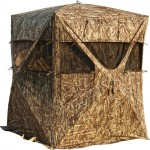Successfully Hiding a Ground Blind
 When hunting from the ground, hiding one’s blind is even more important than when hunting from a tree. The ground is the terrain that the deer traverse on a daily basis. It is their home, and they are very used to the way that it smells, the way that it looks, and the way that it has been for years and years. Thus, when putting in a new ground blind, they will very quickly notice that it is there if it is not well hidden. They may notice it even if it is hidden, but they will become used to it very quickly if it feels like a part of the forest, not like something foreign. To a deer, things that are foreign are things that feel dangerous. The hunter wants the deer to feel completely safe and at home around the blind, so that they will not suspect it of anything and will come up close, calm and unafraid, during hunting season. There are a few good ways to hide a blind using natural cover — natural cover is a must, as the deer are already familiar with it — so that the hunter can enjoy a great deal of success.
When hunting from the ground, hiding one’s blind is even more important than when hunting from a tree. The ground is the terrain that the deer traverse on a daily basis. It is their home, and they are very used to the way that it smells, the way that it looks, and the way that it has been for years and years. Thus, when putting in a new ground blind, they will very quickly notice that it is there if it is not well hidden. They may notice it even if it is hidden, but they will become used to it very quickly if it feels like a part of the forest, not like something foreign. To a deer, things that are foreign are things that feel dangerous. The hunter wants the deer to feel completely safe and at home around the blind, so that they will not suspect it of anything and will come up close, calm and unafraid, during hunting season. There are a few good ways to hide a blind using natural cover — natural cover is a must, as the deer are already familiar with it — so that the hunter can enjoy a great deal of success.
One of the best ways to hide a blind is with a fallen tree. In the deep forest, these fallen trees can be found easily, as no one comes through to clear them out. Some of them fall after lightning strikes, others after wind storms, and others after ice storms. The best sort of tree to use is one where the trunk is lying flat along the ground, a bit raised up in the air by the branches beneath it, and with one large branch protruding straight up into the air, still covered with needles. If this can be found, the hunter should put his or her blind directly behind the largest branch, the one going upward. The hunter can then lean forward and shoot out from under this branch, all while resting the barrel of the rifle on the trunk of the tree. It is a perfect sniper’s nest.
If a tree cannot be found that is suitable and close to the deer trails, a hunter is best to tuck his blind in amongst a small grove of trees. Preferably, these will be evergreens, as those are the thickest and provide the best cover. This way, the hunter will have good cover on all sides. He or she will then have to build the blind up in a square or circle within the grove, using broken branches and small trees that have fallen down. It is best to do this without cutting any trees down, as that disturbs the forest the least, but cutting is all right if one has no other choice. Also preferable is building the blind up to the height of the gun while shooting, so that, like with the fallen tree, the hunter has something to rest the barrel of the gun on top of.
A third option is to situate one’s blind on top of a large rock. Deer are not able to get up on such rocks, and so it often does not occur to them to look up. A rock with small trees growing on top of or around it is the best option, if it can be found. This also gives the hunter an excellent vantage point, as they can see for a long distance in all directions. Similarly to hunting from the top of a hill or from a tree stand, this can open up new shooting lanes and give the hunter a great chance at bagging a deer. The hardest thing about this kind of blind is building it up, as its position on top of the rock makes for a lot more work in getting branches and other supplies into position.
The hunter should always choose the best option available for the terrain, and hide their blind as well as they can. Building it early will help the deer to become used to it, and this is also much in the hunter’s favor. A good blind that is well hidden is the beginning of the road toward getting some very good chances at some very large deer.
